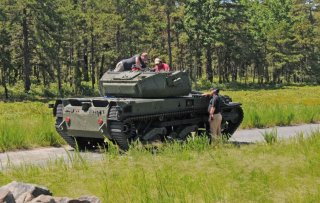The Army’s Robotic Combat Vehicle is Getting Even More High-Tech
Attack possibilities and new tactical applications are greatly multiplied by using an unmanned vehicle, which can integrate many heavy armor technologies into a lighter weight, high-speed, deployable system.
The Army's Robotic Combat Vehicle-Medium (RCV-M) is a fifteen-ton, tracked heavily armed drone being prepared for future warfare. The Army is currently evaluating its performance in conjunction with a variety of technologies, including 30mm Chain Guns, high-fidelity sensors, attack drones, anti-tank missiles, smoke obscurants, and electronic warfare.
Attack possibilities and new tactical applications are greatly multiplied by using an unmanned vehicle, which can integrate many heavy armor technologies into a lighter weight, high-speed, deployable system.
“When you design just to be remote, you can accomplish many of the things of a larger vehicle and a much smaller package, because obviously, you don't have to package people and then you don't have to package protection. And so it's likely that we'll see the kinds of capabilities that historically would track to a larger platform in smaller and lighter platforms,” Maj. Gen. Ross Coffman, Director of the Next-Generation Combat Systems Cross-Functional Team at Army Futures Command, told the National Interest in an interview.
Coffman explained the service is now refining requirements and testing prototype RCV-Ms and plans another intense set of evaluations at Fort Hood, Texas, next year. Some of the Army’s industry partners include Textron Systems, QinetiQ, and General Dynamics Land Systems.
“We're gonna do company-level operations in Texas, using offensive and defensive scenarios, to really hone the requirements in the lessons of some of the things on future battlefields,” Coffman said.
Without needing to operate with heavy armor to protect a crew, a robotic armed vehicle can integrate a wide sphere of technologies to include advanced computing, electronics, multi-domain command, and control equipment, and a wide range of weapons.
“RCVs are payload agnostic. We can have counter-drone, we can have smoke, sensors, and lethality. We can have anything that you can imagine on the battlefield on a robot. That is exciting stuff,” Coffman said.
Kris Osborn is the defense editor for the National Interest. Osborn previously served at the Pentagon as a Highly Qualified Expert with the Office of the Assistant Secretary of the Army—Acquisition, Logistics & Technology. Osborn has also worked as an anchor and on-air military specialist at national TV networks. He has appeared as a guest military expert on Fox News, MSNBC, The Military Channel, and The History Channel. He also has a Master’s Degree in Comparative Literature from Columbia University.
Image: DVIDS

